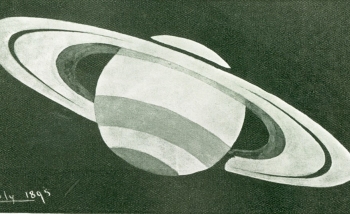The recent detection of flares circling black holes has proven a theory — co-developed more than a decade ago by Perimeter researcher Avery Broderick — about how black holes grow and consume matter.
Astrophysicist Avery Broderick holds the Delaney Family John Archibald Wheeler Chair at Perimeter Institute.[/caption]
“It’s extremely exciting to see our theoretical musing come to life, and that tracking these types of flares about black holes is possible,” said Broderick, an Associate Faculty member at Perimeter Institute and the University of Waterloo, who predicted the flares 13 years ago with collaborator Avi Loeb.
Recently, a discovery by the GRAVITY Collaboration has detailed the detection of three visual hotspots, or flares, emanating from a black hole known as Sagittarius A* (or Sgr A*), which sits at the centre of the Milky Way. The team detected a wobble of emissions coming from the flares, enabling scientists to detect the growing orbit, known as an accretion disk, of the black hole itself.
The idea of using the emissions from visual hotspots to map the behaviour of black holes was first suggested by Broderick and Loeb in 2005 when both were working at the Harvard-Smithsonian Center for Astrophysics.
The pair’s 2005 paper and a 2006 follow-up outlined computer models and highlighted their proposal that the flares were caused by the confluence of two extreme events: the bending of light around the black hole and the generation of hotspots by magnetic reconfigurations (known as magnetic reconnection) that accelerate charged particles to relativistic speeds around Sgr A*. They showed how the hotspots could be used as visual probes to trace out structures in the accretion disk and spacetime itself.
“Black holes are gravitational masters of their domain and anything that drifts too close will be blended into a superheated disk of plasma surrounding them,” said Broderick. “The matter trapped in the black hole’s growing retinue then flows towards the event horizon — the point beyond which even light cannot escape the intense gravity — and consumed by the black hole via mechanisms that are not yet fully understood.
“We believed if flare timescales were close to orbital timescales around a black hole, they could actually represent bright features that were embedded within the accretion disk and help us understand the behaviour and growth of black holes,” said Broderick.
The study, published today in Astronomy and Astrophysics, detected the flares emanating from Sgr A* earlier this year on the European Southern Observatory’s Very Large Telescope in Chile. While the hotspots couldn’t be fully revolved using the telescope, the GRAVITY Collaboration recognized the wobble of emission from the flares as the associated hotspots orbited the supermassive black hole.
Simulation of a hotspot shearing around Sgr. A*, by Avery Broderick and collaborators:
Simulation showing a synthesis of the radio, infrared centroid and light curves of a shearing hotspot around a black hole:
New York Times video exploring the science of Sagittarius A*:
Interview with Avery Broderick about the new research:
Further exploration
About PI
Perimeter Institute is the world’s largest research hub devoted to theoretical physics. The independent Institute was founded in 1999 to foster breakthroughs in the fundamental understanding of our universe, from the smallest particles to the entire cosmos. Research at Perimeter is motivated by the understanding that fundamental science advances human knowledge and catalyzes innovation, and that today’s theoretical physics is tomorrow’s technology. Located in the Region of Waterloo, the not-for-profit Institute is a unique public-private endeavour, including the Governments of Ontario and Canada, that enables cutting-edge research, trains the next generation of scientific pioneers, and shares the power of physics through award-winning educational outreach and public engagement.
You might be interested in

Spiralling light from M87’s supermassive black hole reveals strong magnetic fields
November 8, 2023


